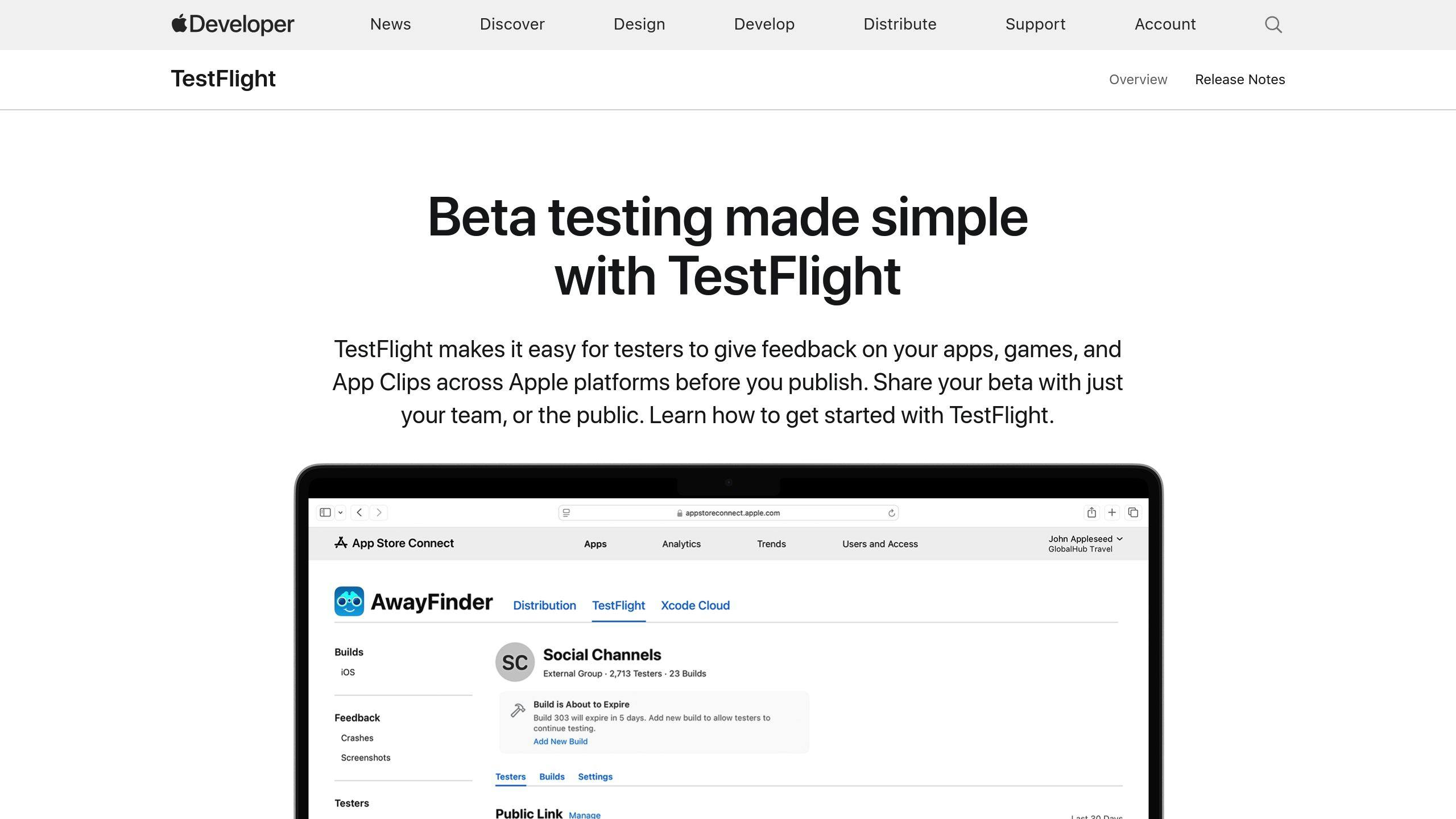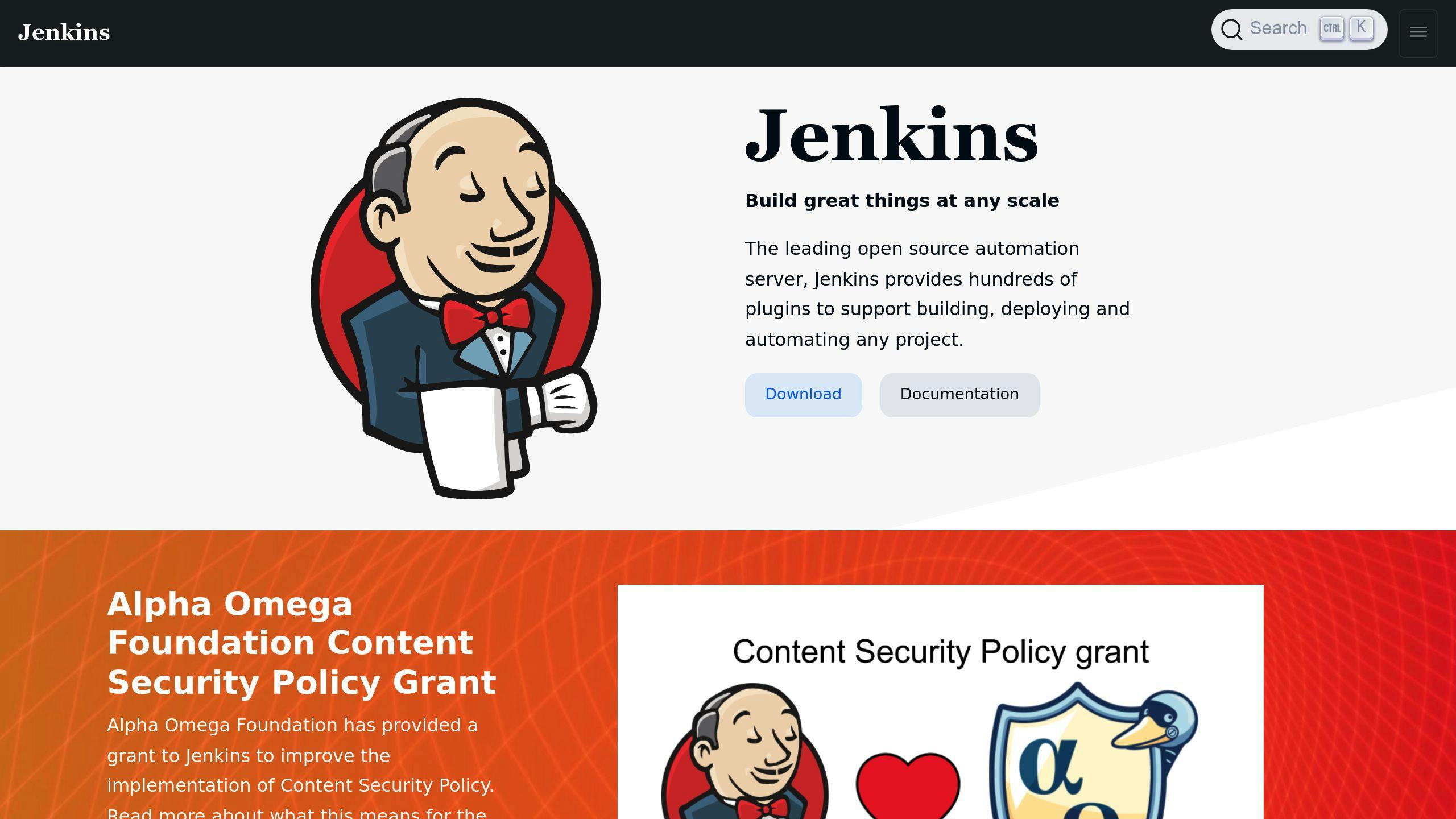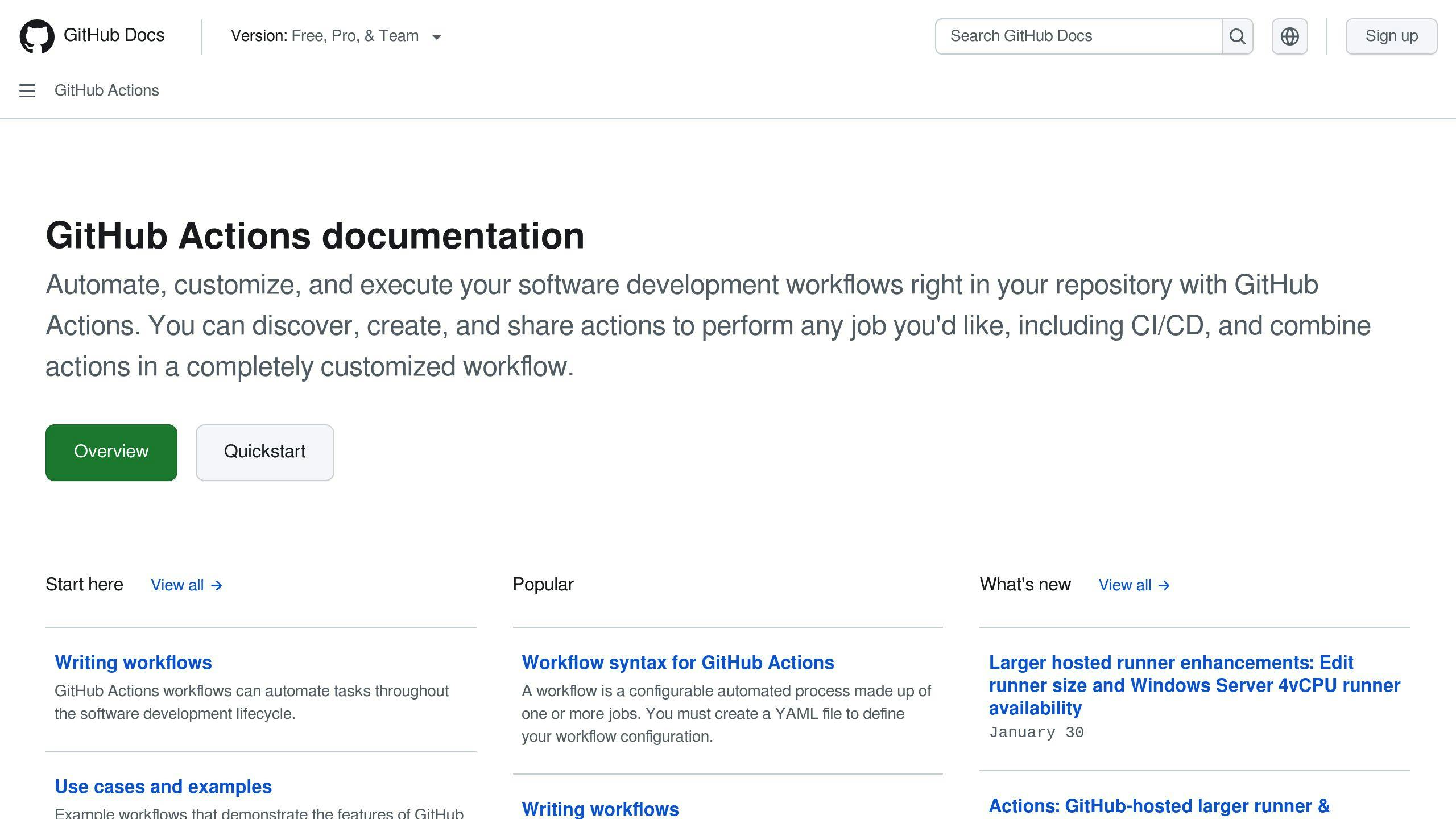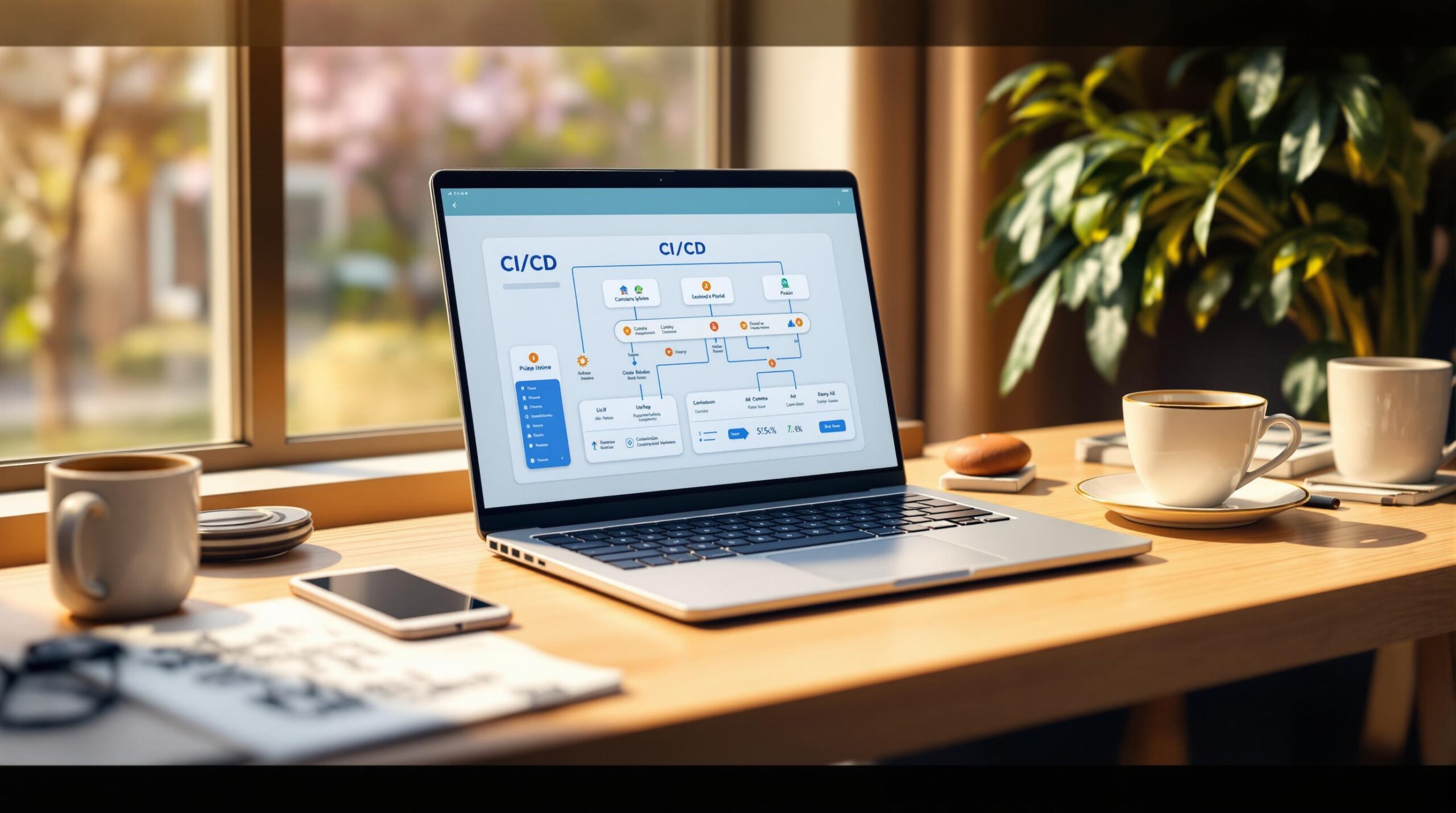
Want faster app updates and fewer bugs? CI/CD pipelines can help you achieve that. Continuous Integration and Continuous Deployment (CI/CD) automate tasks like code integration, testing, and deployment, reducing development time by 20% and post-deployment defects by 80%. Here’s why CI/CD is essential for mobile app development:
- Faster Releases: Automate builds, tests, and deployments for quicker rollouts.
- Better Code Quality: Catch bugs early with automated testing.
- Team Collaboration: Streamline workflows for developers and QA teams.
- Platform-Specific Tools: Use tools like Bitrise for mobile-focused automation.
Key Differences for Mobile Apps:
- Manage iOS and Android builds.
- Test across devices and OS versions.
- Handle app store submission rules.
Quick Setup Tips:
- Use tools like Bitrise, Jenkins, or GitHub Actions for automation.
- Automate testing (unit, integration, UI) and app signing.
- Optimize pipelines with caching and parallel execution.
- Distribute apps via TestFlight or Google Play with staged rollouts.
Quick Comparison:
| Tool | Best For | Key Features | Considerations |
|---|---|---|---|
| Bitrise | Mobile CI/CD | Pre-built workflows, no server mgmt | Specialized for mobile teams |
| Jenkins | Custom workflows | Highly customizable, self-hosted | Requires maintenance and setup |
| GitHub Actions | GitHub projects | Git integration, cloud-based | Needs extra config for mobile apps |
With CI/CD, mobile teams can cut release times by 75% and deliver high-quality apps faster. Ready to transform your mobile development? Let’s dive in.
What is CI/CD, and how to use it for mobile apps?
How to Set Up a CI/CD Pipeline for Mobile Apps
Creating a CI/CD pipeline for mobile apps involves thoughtful planning and selecting the right tools to streamline your development workflow. Here’s how you can get started.
Picking the Right CI/CD Tools
The tools you choose play a big role in automating your mobile app development process. Here’s a quick comparison of some popular options:
| Tool | Best For | Key Features | Considerations |
|---|---|---|---|
| Bitrise | Mobile app development | 300+ pre-built steps, managed service SLA | No server management needed, quick setup |
| Jenkins | Custom workflows | Self-hosted, highly customizable | Requires regular server upkeep and plugin updates |
| GitHub Actions | GitHub-integrated projects | Native Git integration, cloud-based | May need extra configuration for mobile apps |
Bitrise stands out for mobile teams thanks to its specialized features and ease of use [5].
Setting Up Version Control for CI/CD
Your Git repository should be configured to support smooth CI/CD operations. Here’s what to include:
- Branch Protection Rules: Prevent direct pushes to main branches.
- Automated Code Review: Require pull request reviews before merging.
- Commit Message Standards: Use consistent commit messages for easier tracking.
Ensure your version control setup integrates well with your CI/CD tool. For instance, Bitrise can automatically trigger builds based on Git events like pull requests or merges [6].
Once version control is ready, you can start designing a workflow to automate key stages of your app’s development.
Creating a Simple CI/CD Workflow
Take inspiration from Rippling, which used Bitrise to speed up their CI/CD pipeline, cutting release times by 75% [5]. Here’s how you can structure a similar workflow:
1. Initial Setup
- Configure your build environment and add signing credentials.
2. Automated Build Process
- Clone the repository, install dependencies, and compile the code.
- Run static code analysis.
- Generate build artifacts.
3. Testing Integration
- Run unit, integration, UI, and performance tests.
Focus on automating tasks that take the most time. Use caching to make builds faster – Bitrise, for example, offers caching features that can greatly reduce dependency resolution and build times [5].
Automating Builds and Tests
Setting Up Automated Builds
Automating builds for different environments is a game-changer for maintaining consistent quality. To get started, create separate workflows for debug and release builds.
For iOS apps, ensure your pipeline handles both development and production signing profiles. On Android, set up distinct configurations for debug and release builds, incorporating tools like ProGuard to optimize and secure your code.
Here’s how mobile teams typically organize their build automation:
| Build Type | Trigger | Benefits |
|---|---|---|
| Debug | Pull Request | Quick feedback for developers |
| Staging | Merge to develop | Thorough QA before release |
| Production | Release branch | Automated store submission |
Adding Unit and UI Tests
Automated testing plays a huge role in ensuring app quality. Rippling’s team reported that integrating automated tests into their CI/CD pipeline significantly improved app reliability and sped up releases [5].
Organize your tests by execution speed for maximum efficiency:
- Unit tests: Focus on core business logic.
- Integration tests: Verify API interactions.
- UI tests: Cover critical user flows.
For UI testing, tools like XCTest (iOS) and Espresso (Android) are great options. Running these tests on virtual devices can help catch visual issues early in the process.
Reducing Build Times
After setting up automated tests, the next challenge is speeding up your build times to enhance feedback and deployment.
Here’s how you can optimize:
- Caching and Resource Management: Use tools like Bitrise to cache dependencies, which can cut build times by up to 60% [4].
- Parallel Execution: Run independent tasks, such as unit tests and debug builds, at the same time.
- Performance Monitoring: Keep an eye on pipeline metrics to identify and eliminate bottlenecks.
Here’s what to aim for in an optimized pipeline:
| Metric | Target | Impact |
|---|---|---|
| PR Build Time | < 10 minutes | Faster developer feedback |
| Release Build | < 30 minutes | Quick deployment capability |
| Test Coverage | > 80% | Strong quality assurance |
sbb-itb-7af2948
Simplifying App Distribution and Deployment
Automating App Signing and Profiles
Automating app signing is a key step for both iOS and Android development. Tools like Fastlane (for iOS) and Google Play App Signing (for Android) make managing profiles and certificates much easier. Additionally, Bitrise Certificate Manager offers a secure, cloud-based solution for storing certificates across both platforms.
| Platform | Signing Solution | Benefits |
|---|---|---|
| iOS | Fastlane Match | Keeps team certificates in sync |
| Android | Google Play App Signing | Ensures secure key storage |
| Both | Bitrise Certificate Manager | Provides cloud-based security |
Once signing is automated, the focus shifts to seamless distribution for both testing and production environments.
Deploying to TestFlight and Google Play
Streamlining deployments to TestFlight and Google Play can significantly speed up app delivery. For TestFlight, automation can handle tasks like versioning, IPA generation, managing beta groups, and sharing release notes. On the Android side, Google Play’s API supports smooth uploads to testing tracks.
Bitrise’s cloud infrastructure stands out as a reliable tool for mobile teams. For example, Rippling transitioned to a cloud-based CI/CD pipeline and achieved 75% faster release times compared to their earlier setup [5].
After distribution, staged rollouts and feature flags become essential tools for managing updates effectively.
Using Staged Rollouts and Feature Flags
Staged rollouts help reduce risks by gradually increasing user access to new updates. On Google Play, you can control what percentage of users receive the update at any given time. Pair this with Firebase feature flags, which let you toggle specific functionalities on or off without needing a full rollback.
A typical process involves starting with a small percentage of users, monitoring performance metrics, and expanding access if no problems arise. Feature flags allow you to quickly disable any problematic features before they impact all users.
Best Practices for Mobile CI/CD Pipelines
Keeping Your CI/CD Pipeline Secure
Managing sensitive information like API keys and certificates is crucial in mobile CI/CD pipelines. Tools such as HashiCorp Vault are often used to handle this securely. By integrating with platforms like Jenkins and Bitrise, Vault ensures secrets are managed safely during automated builds and deployments. It offers encrypted storage and allows access control based on user roles.
| Security Measure | Purpose | Implementation |
|---|---|---|
| Encrypted Vaults & Role-based Access | Protect sensitive data and limit access by roles | Tools like HashiCorp Vault |
| Regular Updates | Ensure security patches are applied | Automated security scanning |
Adding Code Quality Checks
Integrating SonarQube with Jenkins can significantly improve code quality for mobile apps. SonarQube scans for issues such as vulnerabilities, code smells, and technical debt (inefficient code that could hinder future development). It generates detailed reports, helping teams maintain high coding standards.
Monitoring and Improving Pipeline Performance
Keeping a close eye on your mobile CI/CD pipeline helps identify bottlenecks and improve efficiency. Tools like Prometheus and Grafana can monitor key metrics, such as build times and test coverage, providing actionable insights for optimization.
| Metric | Target | Impact |
|---|---|---|
| Build Time | Under 10 minutes | Boosts developer productivity |
| Test Coverage | Over 80% | Ensures code reliability |
| Deployment Frequency | Daily | Speeds up release cycles |
To enhance pipeline performance, consider:
- Running tests in parallel to cut down build times.
- Leveraging cloud-based infrastructure for better scalability.
- Regularly reviewing and tweaking pipeline configurations.
These practices help mobile app teams streamline workflows, minimize errors, and accelerate delivery to app stores. A well-maintained CI/CD pipeline ensures secure, efficient, and reliable releases, giving teams an edge in delivering high-quality mobile apps faster [3].
Conclusion: Delivering Mobile Apps Faster and Better
Key Takeaways
Using CI/CD pipelines in mobile app development can simplify workflows and improve how quickly and effectively teams deliver apps. By increasing deployment frequency, teams can react more promptly to market trends and user feedback.
| Metric | Traditional Development | With CI/CD Pipeline |
|---|---|---|
| Development Time Savings | Baseline | Up to 20% reduction [1] |
| Deployment Frequency | Monthly/Weekly | Daily/On-demand |
| Release Cycle Speed | Standard | Up to 75% faster [5] |
These advantages highlight why adopting CI/CD pipelines is a smart move for mobile app teams.
How to Get Started with CI/CD
- Pick Tools Built for Mobile: Opt for platforms like Bitrise, which offer over 300 integrations and workflows tailored for mobile development [2].
- Focus on Security and Monitoring: Protect your pipelines with features like SAML SSO and two-factor authentication. Track key metrics such as deployment frequency and recovery time to keep improving [2].
FAQs
Here, we address some common questions about tools used in mobile CI/CD pipelines.
What is Jenkins in iOS?
Jenkins is an open-source CI/CD tool often used in iOS development. It offers a wide range of plugins for building, testing, and deploying apps. However, it requires a lot of manual setup and ongoing maintenance. If your team values flexibility and customization, Jenkins can be a strong choice, though it comes with higher upkeep requirements [1].
What is the difference between GitHub Actions and Bitrise?
GitHub Actions and Bitrise serve different purposes and offer distinct experiences:
| Feature | GitHub Actions | Bitrise |
|---|---|---|
| Focus | General-purpose CI/CD | Tailored for mobile CI/CD |
| Setup | Manual for mobile tasks | Pre-configured workflows |
| Infrastructure | Self-managed | Fully managed |
GitHub Actions is highly adaptable but involves manual setup for tasks like iOS signing and TestFlight integration. Bitrise, on the other hand, provides ready-to-use workflows and features designed specifically for mobile development, saving considerable setup time [2].
The choice between the two depends on your team’s needs. If you’re working across multiple platforms and need flexibility, GitHub Actions might be the better fit. However, for mobile-focused teams, Bitrise’s tailored workflows and managed infrastructure are often more efficient [5].
